Coverage of the Winter CES is the only thing to get really excited about in this issue, unfortunately. Readers learned, perhaps for the first time, of NEC's endeavors towards an upgraded BIOS (what would eventually be called CD•ROM2²) and a new console that consolidated this new BIOS with NEC's existing hardware (the as-yet-unnamed "DUO" console). In addition, Victor Ireland reports on several CD-ROM titles that, ultimately, were never released for TG-16, such as: Discis Book (a port of a PC/Mac CD-ROM educational title), Super Big Strategy (an installment of Daisenryaku, a popular war strategy series), Astralius (an RPG from IGS), and—are ready for it?
No, seriously: can you guess the fourth game that was announced but never released? Come on, take a guess. Wait, did I hear somebody scream Pit Fighter?
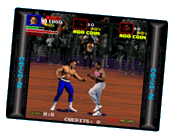
"Atari Games' super arcade hit will come to the TurboGrafx-16 courtesy of Tengen. Following the crowd, Tengen intends to pack all the digitized graphics of the arcade version on CD for release in the fall of 1991."
VIEW SOURCE
Yes! Pit Fighter is listed as one of the upcoming titles for autumn of 1991. Now, before you start giggling, let us recall that this fad (digitized graphics in fighting games) was still all the rage at this time. Yes, it was a gimmick. And yes, Pit Fighter was a mediocre arcade game, at best. But let's forget those "minor" details and allow ourselves to imagine just how "splendid" a TG-16 port of Pit Fighter could have been…
Continued below…
Table of Contents for TurboPlay #5▲
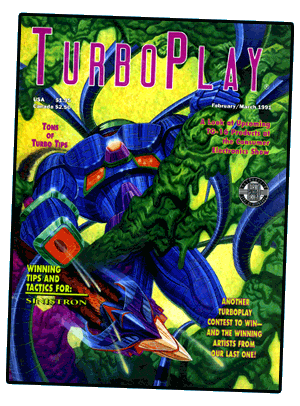
- 01 Cover: Sinistron (1991, HuCARD). Artist: Alan Hunter (uncredited).
- Inspired by IGS's horizontal shooter, this artwork adorns the Sinistron strategy guide as well as the cover.
-
- 02 TurboMail: Letters from our loyal readers.
- "A look inside the TurboPlay mailbag at letters from TG-16 enthusiasts around the country. Is your letter going to be answered this issue?" Topics include: will SuperGrafx be released in North America?, will NEC sell games directly?, when will TV SPORTS Baseball (HuCARD) be released?, etc.
-
- 03 Table of Contents for issue #3.
- "We're also planning to increase the size of TurboPlay in the near future…" - Editors' optimistic outlook on the magazine's prospects.
-
- 04 TurboPlay Contest: New Contest & Previous Winners. 04 05
- See the eleven winning entries from the October / November TurboPlay Drawing Contest! New contest: "Ten winners will be picked randomly…each will be awarded a copy of the new Bonk's Revenge game when it rolls off the production line. Sound good?"
-
- 06 Advertisement: TurboGrafx-16 Console + Bonk's Adventure Free. 06 07
- "Buy TurboGrafx-16 now and get Bonk's Adventure for free. A $50 value."
-
- 08 Feature: Winter CES Report (1991). 08 09 10 11
- "A look at the closed-to-the-public Winter Consumer Electronics Show. NEC and its licensees have lots of great games in the works."
- NOTEWORTHY: Discis (TG-CD) (Expected in second half of 1991, Unreleased), CD+G versus CD+IG (Interactive Graphics), TV SPORTS Baseball (Expected July 1991, Unreleased), TV SPORTS Boxing (Expected in Winter 1991, Unreleased), TurboExpress now $299.99 (not $249.99, as expected, due to increased cost of LCD displays), NEC's NID 100:1 image compression.
-
- 12 Strategy Guide: Sinistron. 12 13 14 15 16 17
- "Wipe the sweat off your TurboStick for a minute and pick up this detailed guide to defeating the planet-gobbling bio-morphic being and its minions. We know you can make it out alive."
-
- 18 Closer Look: TurboChip & TG-CD Game Reviews. 18 19 20
- "Reviews of Jack Niklaus Turbo Golf (HuCARD, CD) and Magical Dinosaur Tour (CD)."
-
- 21 TurboTips: Codes, Tips and Tricks. 21 22 23
- "More slick tricks for Blazing Lazers, Devil's Crush, Dragon's Curse, Dragon Spirit, Keith Courage, Legendary Axe II, Neutopia, Tricky Kick, Wonderboy III: Monster Lair, World Class Baseball, World Court Tennis and Ys: Book I & II.
-
- 24 Feature: TurboPlay Rates the Games. 24 25 26 27 28
- "There aren't many TG-16 owners that have all of the TurboChips and CDs made for the system. For that reason, TurboPlay's Donn Nauert has made a listing of all the games currently available and rated them to help you become a more informed buyer. Do you agree with his assessments?"
-
- 29 Advertisement: TurboGrafx-16, TurboExpress, TurboVision (TV Tuner). 29 30 31
- "If you can play it here, you can play it anywhere!"
-
- 32 Advertisement: Tricky Kick, Sinistron (1991, HuCARD).
- "Power up your brain with over 120 perplexing puzzles in Tricky Kick and experience high-tech bio-morphic action in Sinistron."
▲
-
TENGEN, THE THIRD PARTY THAT NEVER WAS…▲
Tengen had already released a great port of KLAX (HuCARD) for TG-16 in August of 1990. And we now know that Tengen had been working on porting another puzzle-action game from the arcade—Atari's Off the Wall (HuCARD)—which was never released:
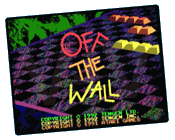
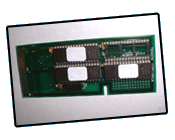
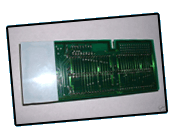
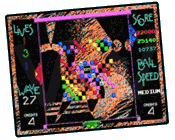
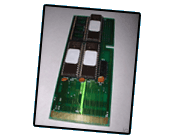
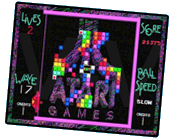
Like KLAX before it, Off the Wall exudes a distinctly late-80's / early-90's aesthetic and flair. You gotta love it. The prototype for the TurboGrafx-16 port of Tengen's Off the Wall was auctioned (via eBay) to a private party in June of 2005. The screenshots indicate an option for three-player—in addition to single player—modes of play. Atari Games, Tengen Limited and Tengen Incorporated are credited on the title screen, suggesting that the HuCARD was planned for a 1992–1993 release. SOURCE: Photos from original eBay auction.
Given this information, it seems plausible that Tengen was considering to port Pit Fighter (and possibly other titles) to the TG-16…so what happened? Was Tengen worried about disappointing TG-16 software sales (i.e. how poorly had the KLAX HuCARD sold for them)? Perhaps Tengen's resources were tied-up in extraneous legal troubles (i.e. the ongoing Tengen vs. Nintendo turmoil)? Or, did TurboGrafx-CD simply lack a user-base large enough for Tengen realize their desired profit margin? Or perhaps some wise guru at NEC realized that Pit Fighter was a less-than-spectacular game?


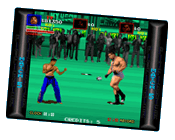
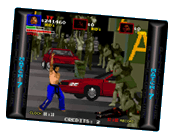
Pit Fighter (Atari) hit the arcades in August of 1990. Yes, after spending a thrilling afternoon playing Pit Fighter at the arcade in the local mall, you could stop by Electronics Boutique and pick up KLAX, which was just released for TG-16. The digitized graphics in Pit Fighter were a novelty for the time and generated a lot of interest from arcade denizens. Apparently, Atari was really pushing multi-player games during this era: Pit Fighter, Off the Wall, and Rampart all supported three players. Who needs four players (à la Gauntlet, Atari's earlier multi-player success), when you have three players?
Regardless of Tengen's reasons for withdrawing support for NEC's console, I still mourn the loss of Pit Fighter for TG-CD. Actually, I'm not entirely joking. Tengen could have been a phenomenal third-party publisher for the TG-16 (especially if we forget about Pit Fighter and consider Atari's catalog of arcade games). And, considering how popular the beat-em-up genre was at the time, Pit Fighter might have sold pretty well for Tengen (especially since TG-16 was starved for beat-em-ups). Pit Fighter for TG-CD would probably have sold decently enough, despite being a less-than-mediocre game, if only because it had no competition in the TG-16 library! Sad but true. Also, I might as well be honest with you: I still remember when my brother and I first saw Pit Fighter in the arcade. We thought it was the koolest thing around. Oy! Those were the days…
Ultimately, KLAX would be the sole title Tengen brought to the TG-16. As such, Tengen joined the ranks of Accolade (Turrican, HuCARD) and Radiance Software (Sidearms, HuCARD) as the least prolific third parties for TG-16. Each company published but one game apiece.
ASIDE: Forget about Pit Fighter; I wish a super-deluxe, enhanced version of Rampart was released for TG-CD, replete with a glorious Red Book soundtrack.
▲
IGS, THE THIRD PARTY THAT WAS…▲
Since we're on the subject of games that were announced but never released, let's discuss Astralius (Mateki Densetsu Astralius, 1991, CD). Supposedly, IGS had actually started the localization of this RPG before pulling the plug on the project altogether. Now this was truly a shame, since it looked like a promising title (i.e. the storyline and puzzles had musical motifs).
Astralius—Here's a huge role-playing game (RPG) on CD in which players must travel to four hostile "continents" (ice, rock, desert, fire) to recover a silver flute that will return music and happiness to the land. During the game, the player is assigned three traveling companions, each with special powers. One unique feature comes in some cities, where the direction from which you enter on the overhead map affects what portion of the city will be displayed on the close-up map. This adds some depth by requiring the player to remember how he entered each city.
Battles are fought with music, and spells cast in battle are graphically represented by robots, fire creatures and genies that attack opponents. The overhead maps in this game leave quite a bit to be desired, but the close-up maps (inside cities, castles, caves, etc.) are visually appealing. Also, the combat interface will appeal to those who do not like the "bumping" interface of Ys, because it is closer to that of a "true" RPG.
VIEW SOURCE
IGS was one of first third-party publishers for TG-16, and with four TG-16 titles already under their belt (Sonic Spike, Tricky Kick, Sinistron and CyberCore), it seemed as if Astralius actually had a chance of making it over here. Of course, in contrast to the simple HuCARD games IGS released for TG-16, a CD-ROM RPG like Astralius would have been significantly more expensive and labor-intensive to localize (i.e. translating all the in-game text, recording new voice-acting for the cinemas, etc.). I wouldn't be surprised if IGS was worried about their ability to realize a return on their investment with a project like Astralius.
But was Astralius a good game? Victor Ireland's description seems a bit hyperbolic:
Astralius…promises to be one of the best games to date. This one is said to give both Ys games a serious run for the top honor. It should prove to be one of the toughest games made as well.
VIEW SOURCE
Mr. Ireland really opens himself up to criticism when he so favorably compares Astralius to Ys. Astralius is outclassed by the Ys series in every respect. Trusted friends assure me that Astralius is a mediocre title, at best, and that I mustn't mourn the absence of a North American version (especially since it is unlikely that IGS would have re-vamped the cumbersome game mechanics critics fault it for). They're probably right, but I can't help but wonder how things would have turned out if Astralius had received a decent localization. At the time, only a handful of RPG's were available in the TG-16/TG-CD library, which suggests that IGS had correctly identified a niche market for their game.
▲
NEC'S STRATEGY FOR 1991…▲
According to Victor Ireland's coverage of the Winter CES in this issue, NEC successfully sold-out the initial shipment of their TurboExpress handheld. Considering that this handheld was very expensive (retailing for $299 USD), this sounds quite impressive. However, we don't know how many units comprised the first shipment. Without basic sales figures, we can only speculate on how "successful" the TurboExpress launch was in North America.
"NEC unveiled its product strategy for the first half of this year at the 1991 Winter Consumer Electronics Show. Trying to build on increased sales of its TurboGrafx-16 console in the second half of 1990 and the sold-out first shipment of its TurboExpress portable, NEC targeted several areas for increased attention in 1991, including CD-ROM, multiplayer games and game quality and quantity."
VIEW SOURCE
Indeed, if there was only one thing to glean from from Victor Ireland's CES reporting, it would be NEC's plan to put more emphasis (and resources) behind the CD-ROM format. This push for CD games in North America was most likely spurred by the phenomenal success NEC was enjoying in Japan with the PC-Engine CD-ROM hardware and software. While the format was gaining momentum in Japan, it was stalling in North America, where cartridges remained the dominant medium for video game consoles. Lest we forget, by 1990, CD-ROM was only just beginning to make headway in the mainstrem home computer market, with so-called "multimedia" computers popularizing the format. In the video game console market, however, CD-ROM was viewed as an expensive "novelty" peripheral.
At the dawn of 1991, the cartridge was still considered the most viable medium for home consoles. Even with the advent of multimedia PC's and Macs, many developers, publishers and consumers had limited experience with CD-ROM hardware and software. Given this state of affairs, NEC pursued a bold (albeit risky) strategy for North America:
"NEC is putting strong emphasis on CD-ROM products during 1990. Fully 50% of the new products released for the TurboGrafx-16 in 1991 will be on CD-ROM."
"Another long-standing rumor heard once again at the show was that NEC will be getting more aggressive with their pricing on the TurboGrafx-CD unit. With more titles available for the unit and many more on the way, NEC wants to get the TurboGrafx-CD into as many homes as possible. Look for either a $50 rebate or a drop in the suggested retail of the unit by summer."
VIEW SOURCE
Now, I have yet to analyze the ratio of HuCARD-to-CD titles released in 1991 (and thereafter), but it will be interesting to see if NEC followed their stated marketing plan. One of the reasons why NEC was eager to push CD-ROM in the gaming industry was because they were getting ready to introduce CD•ROM2² (256K RAM), an upgraded BIOS that improved upon the original CD-ROM² (64K RAM) format and promised to deliver even more spectacular games to the console. Clearly, as early as 1990-1991, NEC had fully committed themsleves to CD-ROM. In fact, Mr. Ireland reports that NEC was not only developing a new BIOS HuCARD (System Card 3.0), but a new console as well (later released in Japan as the DUO and in North America as the TurboDuo).
▲
Return to top of page…